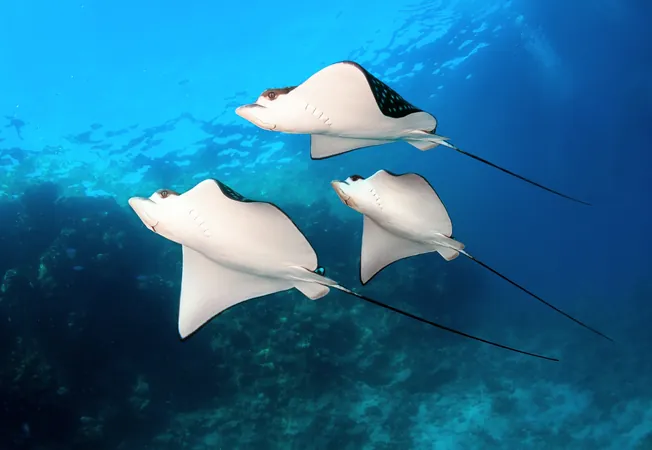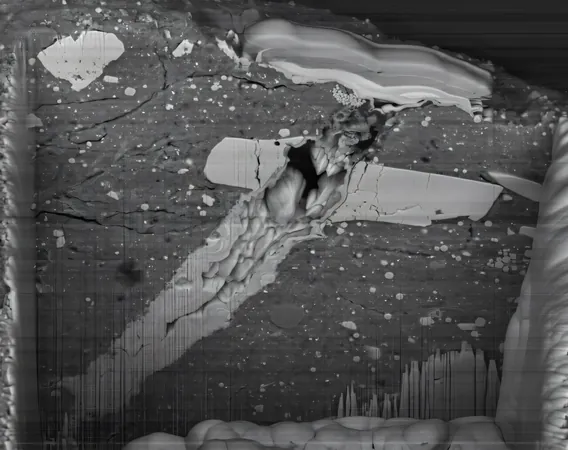
Revolutionizing Marine Conservation: The Bold New Tracking of Endangered Eagle Rays
2025-07-26
Author: Jacques
Marine scientists are taking bold strides in conservation efforts, targeting one of the ocean's most elusive creatures: the endangered whitespotted eagle ray. Unlike their more frequently studied relatives, these magnificent rays have largely evaded tracking technologies due to their unique physical attributes.
Traditionally, researchers have successfully tagged species like sharks and turtles to monitor their movements, but rays posed a significant challenge. Their smooth, flat bodies make it hard to attach devices without them falling off after only a few hours of tracking.
Introducing a Game-Changing Tag
Now, thanks to Dr. Matt Ajemian and his team at Florida Atlantic University, a breakthrough has emerged: a lightweight tagging system that allows for tracking eagle rays for up to an impressive 60 hours. This innovation not only advances our understanding of the species but opens up new avenues for marine conservation.
The Challenges of Tracking Eagle Rays
Eagle rays are notoriously difficult to study in their natural habitats. Their flat bodies lack a prominent dorsal fin for secure tagging, and their velvety skin prevents adhesives from sticking. Additionally, their migration across various marine environments poses further challenges for researchers.
Conservation regulations also limit the time scientists can handle these creatures, leaving them with mere seconds to attach the tagging equipment. Consequently, there have been fewer than ten published studies detailing the fine-scale behaviors of pelagic rays, compared to hundreds for sharks.
How This New Technology Works
The groundbreaking tag developed by the Harbor Branch team houses a camera, motion sensors, hydrophone, satellite pinger, and acoustic beacon, all in a compact design lighter than a paperback book. It utilizes silicone suction cups for attachment, but the revelation is a soft strap that secures to the ray's spiracles, ensuring a snug fit without damaging its skin.
Dr. Ajemian shared that the aim was to devise a system operable within seconds that could survive during natural behaviors while collecting extensive data. In initial sea trials off Bermuda, ten tagged rays retained their devices for an average of 21 hours, with one individual keeping it for a remarkable 59.2 hours—three times longer than previous records.
Discovering Underwater Behaviors
Video footage from the tagging revealed incredible insights into eagle ray behaviors, showcasing them gliding through seagrass and coral rubble. Remarkably, researchers were able to identify complex behaviors like clam-crunching using solely sound and movement data.
Audio recordings captured the distinctive sounds of shells cracking, even when video was off to conserve battery life. Motion tracking displayed unique swimming patterns and frantic activity when the rays dug for food.
Harnessing AI for Behavioral Insights
Equipped with advanced IMU technology, the tag recorded an extensive range of data every second. Using machine learning algorithms, the research team successfully classified ray activities with startling precision, distinguishing between swimming, browsing, and digging behaviors.
These developments could mean a future where we fully understand not just eagle rays but potentially other marine species, enhancing our ability to monitor and protect marine ecosystems.
Protecting and Preserving Eagle Rays
The plight of the eagle ray is pressing, as their populations have suffered a staggering decline of 50 to 79 percent over the last 30 years due to bycatch and habitat destruction. This new tracking technology is vital, as it allows conservationists to identify key feeding areas and adjust fishing practices to minimize harm.
With the new tag technology showcasing that eagle rays often linger around critical habitats, this data can lead to more informed conservation strategies. It might even assist in regulating boat speeds around hotspots where rays are frequently found.
The Future of Tracking
Looking forward, slimmer sensor technologies could turn eagle rays into bio-monitors, providing continuous data on ocean health, from water quality to noise pollution. The tagging method could also extend to other species within the ray family.
As research evolves, combining data from rays and other marine life could unravel the intricate web of ecosystems in tropical coastlines, significantly enhancing our understanding of predator-prey dynamics.
Details of this groundbreaking study can be found in the journal *Animal Biotelemetry*, marking a significant leap forward in marine conservation.









 Brasil (PT)
Brasil (PT)
 Canada (EN)
Canada (EN)
 Chile (ES)
Chile (ES)
 Česko (CS)
Česko (CS)
 대한민국 (KO)
대한민국 (KO)
 España (ES)
España (ES)
 France (FR)
France (FR)
 Hong Kong (EN)
Hong Kong (EN)
 Italia (IT)
Italia (IT)
 日本 (JA)
日本 (JA)
 Magyarország (HU)
Magyarország (HU)
 Norge (NO)
Norge (NO)
 Polska (PL)
Polska (PL)
 Schweiz (DE)
Schweiz (DE)
 Singapore (EN)
Singapore (EN)
 Sverige (SV)
Sverige (SV)
 Suomi (FI)
Suomi (FI)
 Türkiye (TR)
Türkiye (TR)
 الإمارات العربية المتحدة (AR)
الإمارات العربية المتحدة (AR)